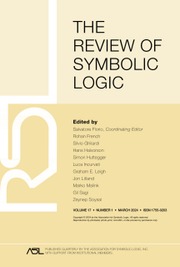No CrossRef data available.
Article contents
EXPLAINING WITH REASONS: FROM ARISTOTLE TO MACHINE LEARNING CLASSIFIERS
Published online by Cambridge University Press: 28 August 2025
Abstract
Explanations, and in particular explanations which provide the reasons why their conclusion is true, are a central object in a range of fields. On the one hand, there is a long and illustrious philosophical tradition, which starts from Aristotle, and passes through scholars such as Leibniz, Bolzano and Frege, that give pride of place to this type of explanation, and is rich with brilliant and profound intuitions. Recently, Poggiolesi [25] has formalized ideas coming from this tradition using logical tools of proof theory. On the other hand, recent work has focused on Boolean circuits that compile some common machine learning classifiers and have the same input-output behavior. In this framework, Darwiche and Hirth [7] have proposed a theory for unveiling the reasons behind the decisions made by Boolean classifiers, and they have studied their theoretical implications. In this paper, we uncover the deep links behind these two trends, demonstrating that the proof-theoretic tools introduced by Poggiolesi provide reasons for decisions, in the sense of Darwiche and Hirth [7]. We discuss the conceptual as well as the technical significance of this result.
MSC classification
Information
- Type
- Research Article
- Information
- Copyright
- © The Author(s) 2025. Published by Cambridge University Press on behalf of The Association for Symbolic Logic


